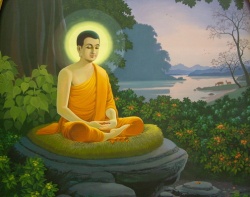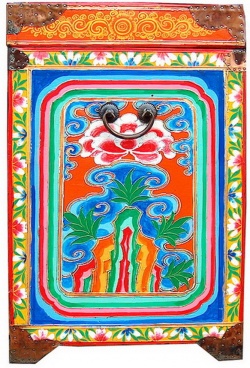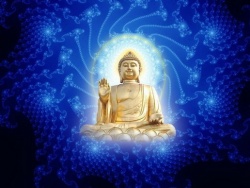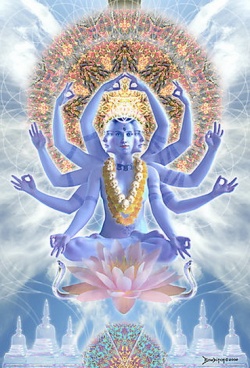Difference between revisions of "Ekayāna"
| Line 5: | Line 5: | ||
[[Pali Canon]] | [[Pali Canon]] | ||
| − | The [[Nikayas]] feature a related term, ekāyana (typically translated as "direct way" or "only way") in the [[Satipatthana Sutta]] (DN 22). That influential text uses the term [[ekāyana]] to describe a number of [[meditation]] techniques intended for the [[cultivation]] of [[mindfulness]]. While [[ekāyana]] (formed from the words eka and ayana) is not the same term as [[ekayāna]] (formed from eka and [[yāna]]), both terms express the {{Wiki|metaphor}} of a journey toward the [[attainment]] of [[Buddhist]] [[awakening]]. Past and {{Wiki|present}} {{Wiki|East Asian}} [[Buddhists]] have seen the same combination of characters ([[一乘]]) signifying [[ekāyana]] in the [[Agamas]] ({{Wiki|Chinese}} translation of the [[Nikayas]]) as well as [[ekayāna]] in {{Wiki|Chinese}} translations of [[Mahayana texts]]. Nevertheless, in contrast to [[yāna]], whose {{Wiki|etymological}} [[root]] is yā, the [[root]] of [[ayana]] is ya. While both [[roots]] connote "going" in [[Sanskrit]], the {{Wiki|distinction}} remains somewhat significant because yā is more likely than ya to also connote a "[[vehicle]]". | + | The [[Nikayas]] feature a related term, [[ekāyana]] (typically translated as "[[direct way]]" or "[[only way]]") in the [[Satipatthana Sutta]] (DN 22). That influential text uses the term [[ekāyana]] to describe a number of [[meditation]] techniques intended for the [[cultivation]] of [[mindfulness]]. While [[ekāyana]] (formed from the words eka and ayana) is not the same term as [[ekayāna]] (formed from eka and [[yāna]]), both terms express the {{Wiki|metaphor}} of a journey toward the [[attainment]] of [[Buddhist]] [[awakening]]. Past and {{Wiki|present}} {{Wiki|East Asian}} [[Buddhists]] have seen the same combination of characters ([[一乘]]) signifying [[ekāyana]] in the [[Agamas]] ({{Wiki|Chinese}} translation of the [[Nikayas]]) as well as [[ekayāna]] in {{Wiki|Chinese}} translations of [[Mahayana texts]]. Nevertheless, in contrast to [[yāna]], whose {{Wiki|etymological}} [[root]] is yā, the [[root]] of [[ayana]] is ya. While both [[roots]] connote "going" in [[Sanskrit]], the {{Wiki|distinction}} remains somewhat significant because yā is more likely than ya to also connote a "[[vehicle]]". |
[[Indian]] [[Mahayana Buddhism]] | [[Indian]] [[Mahayana Buddhism]] | ||
| Line 19: | Line 19: | ||
Various schools | Various schools | ||
| − | After the division of the [[Mahayana]] from the [[Early Buddhist Schools]], the [[Mahayana]] itself began to develop into {{Wiki|sectarian}} {{Wiki|tendencies}} as different [[philosophical]] trends developed, notably the [[Madhyamaka]], the [[Yogacara]], the [[Tathagatagarbha]]. While the actual historical order of [[appearance]] of the various texts is in considerable [[doubt]], the [[principle]] common to the [[Ekayana]] texts is that they seek to unite the different [[Dharma]] teachings into "[[one vehicle]]" that encompasses all [[Dharmas]] and, in that [[sense]], becomes the supreme [[Dharma]] [[teaching]]. The central point of this unification process is that it is not a single [[doctrine]] that is the " | + | After the division of the [[Mahayana]] from the [[Early Buddhist Schools]], the [[Mahayana]] itself began to develop into {{Wiki|sectarian}} {{Wiki|tendencies}} as different [[philosophical]] trends developed, notably the [[Madhyamaka]], the [[Yogacara]], the [[Tathagatagarbha]]. While the actual historical order of [[appearance]] of the various texts is in considerable [[doubt]], the [[principle]] common to the [[Ekayana]] texts is that they seek to unite the different [[Dharma]] teachings into "[[one vehicle]]" that encompasses all [[Dharmas]] and, in that [[sense]], becomes the supreme [[Dharma]] [[teaching]]. The central point of this unification process is that it is not a single [[doctrine]] that is the "[[one vehicle]]" of [[Buddhism]] but that the actual [[experience]] of [[awakening]], i.e., [[bodhi]], is the [[one vehicle]]. |
[[Chinese Buddhism]] | [[Chinese Buddhism]] | ||
| Line 35: | Line 35: | ||
2. The Small Vehicle's ([[Hinayana]]) [[teaching]]. | 2. The Small Vehicle's ([[Hinayana]]) [[teaching]]. | ||
| − | The Great Vehicle's ([[Mahayana]]) [[teaching]] of [[Dharma characteristics]] ([[dharmalaksana]]). The Great Vehicle's [[teaching]] of destroying {{Wiki|characteristics}}. 5. The One Vehicle's ([[Ekayana]]) [[teaching]] of [[manifesting]] [[Nature]]." | + | The Great Vehicle's ([[Mahayana]]) [[teaching]] of [[Dharma characteristics]] ([[dharmalaksana]]). The Great Vehicle's [[teaching]] of destroying {{Wiki|characteristics}}. 5. The [[One Vehicle's]] ([[Ekayana]]) [[teaching]] of [[manifesting]] [[Nature]]." |
Thus, according to [[Zongmi]] who was a [[lineage]] [[master]] of both [[Huayan]] and [[Chan]], he clearly distinguished the [[Ekayana]] from the [[Mahayana]], and the [[Mahayana teachings]] of [[Yogacara]] (his [[Mahayana]] class and [[Madhyamaka]] (his [[Mahayana]] class 4) were eclipsed by the more profound [[Ekayana]] [[teaching]] of "[[manifesting]] [[nature]]." | Thus, according to [[Zongmi]] who was a [[lineage]] [[master]] of both [[Huayan]] and [[Chan]], he clearly distinguished the [[Ekayana]] from the [[Mahayana]], and the [[Mahayana teachings]] of [[Yogacara]] (his [[Mahayana]] class and [[Madhyamaka]] (his [[Mahayana]] class 4) were eclipsed by the more profound [[Ekayana]] [[teaching]] of "[[manifesting]] [[nature]]." | ||
[[Japanese Buddhism]] | [[Japanese Buddhism]] | ||
| − | As the various [[forms]] of [[Buddhism]] influenced by the [[Ekayana sutras]] came to [[Japan]], the one-vehicle [[teaching]] of the [[Lotus Sutra]] also inspired the formation of the [[Nichiren]] [[sect]]. | + | As the various [[forms]] of [[Buddhism]] influenced by the [[Ekayana sutras]] came to [[Japan]], the [[one-vehicle]] [[teaching]] of the [[Lotus Sutra]] also inspired the formation of the [[Nichiren]] [[sect]]. |
</poem> | </poem> | ||
{{W}} | {{W}} | ||
{{SanskritTerminology}} | {{SanskritTerminology}} | ||
Latest revision as of 19:51, 16 April 2014
Ekayāna is a Sanskrit word that can mean "one path" or "one vehicle". The word took on special significance as a metaphor for a spriritual journey in the Brihadaranyaka Upanishad (II.iv.11 and IV.v.12). Notably, in that text the phrase vedānāṃ vāk ekayānam translates approximately to "the one destination of the Vedas is the spirit of the word".
Pali Canon
The Nikayas feature a related term, ekāyana (typically translated as "direct way" or "only way") in the Satipatthana Sutta (DN 22). That influential text uses the term ekāyana to describe a number of meditation techniques intended for the cultivation of mindfulness. While ekāyana (formed from the words eka and ayana) is not the same term as ekayāna (formed from eka and yāna), both terms express the metaphor of a journey toward the attainment of Buddhist awakening. Past and present East Asian Buddhists have seen the same combination of characters (一乘) signifying ekāyana in the Agamas (Chinese translation of the Nikayas) as well as ekayāna in Chinese translations of Mahayana texts. Nevertheless, in contrast to yāna, whose etymological root is yā, the root of ayana is ya. While both roots connote "going" in Sanskrit, the distinction remains somewhat significant because yā is more likely than ya to also connote a "vehicle".
Indian Mahayana Buddhism
Just as the development of Mahayana Buddhism is obscured in history and legend, the historical appearance of the Ekayana is also unknown.
Influential sutras
At some point the term became in use and appeared in the canonical texts of Mahayana Buddhism. The Ekayana sutras of primary influence are the Lankavatara Sutra, the Avatamsaka Sutra (The Flower Garland Sutra), the Lotus Sutra (The Sutra of The White Lotus of the True Dharma), and the Shurangama Sutra (especially with its Shurangama Mantra encompassing worship of the entire Buddhist Pantheon Hindu pantheon The Heroic Gate Sutra). Other Ekayana sutras are the Śrīmālādevī Simhanada Sūtra (The Lion's Roar of Queen Srimala), the Sraddhotpanna Sutra, and the Mahayana Mahaparinirvana Sutra (The Mahayana Sutra of The Great Parinirvana).
The Indian Sutras of the Ekayana develop the various themes of Buddhism from their unique perspectives, yet share the "One Vehicle" approach to Buddhism. Thus, the Lankavatara Sutra expresses the incisive psychological analysis of the Ekayana, the Avatamsaka Sutra expresses the grandeur of the metaphysical or philosophical all-inclusiveness of the transcendent vision of the Ekayana, and the Lotus Sutra expresses the profundity of the devotional aspect of the Ekayana.
Woven in the Ekayana Sutras are several common themes which may be outlined as: Buddhism is the religious development of the One Buddha Mind, the One Mind is known by many names such as Dharmakaya (the body or essence of Dharma), Buddha-nature, Tathagata-garbha (the Buddha-Matrix, the Fundamental Treasury of the Tathagata, the womb of the One-Who-Comes-Thus), Shunyata (Emptiness), Alaya-vjnana (the Storehouse of Consciousness), etc., since all the teachings of Buddhism, including both Mahayana and the Early Schools, are essentially teachings about the One Buddha Mind they must be taken as an organic whole and this reconciliation of apparent oppositions or contradictions within Buddhist teachings is the synthesis of Ekayana, as all beings share equally the One Mind there is an absolute basis for human equality, (5) realizing this absolute basis of the One Buddha Mind is not accomplished as an intellectual pursuit but must be accomplished by experiential practice, and since all people share this One Mind there is no fundamental distinction between monastics and lay practitioners in the potential for—or actual realization of—awakening in Buddhism.
Various schools
After the division of the Mahayana from the Early Buddhist Schools, the Mahayana itself began to develop into sectarian tendencies as different philosophical trends developed, notably the Madhyamaka, the Yogacara, the Tathagatagarbha. While the actual historical order of appearance of the various texts is in considerable doubt, the principle common to the Ekayana texts is that they seek to unite the different Dharma teachings into "one vehicle" that encompasses all Dharmas and, in that sense, becomes the supreme Dharma teaching. The central point of this unification process is that it is not a single doctrine that is the "one vehicle" of Buddhism but that the actual experience of awakening, i.e., bodhi, is the one vehicle.
Chinese Buddhism
While the "One Vehicle" Buddhism died in India along with the rest of Buddhism, it became a key aspect of the Chinese acculturation and acceptance of Buddhism. The Chinese assimilation of Buddhism met in the vast diversity of Buddhist texts the problem of sorting through them for the core of Buddhist teaching. This problem was solved by the greatest Buddhist minds of China by taking up one or more of the Ekayana Sutras as central to the understanding of the diversity of Buddhism. The doctrines and practices of Tiantai (J. Tendai) and Huayen (J. Kegon) Buddhist sects were able to present a synthesis of the diversity of Buddhism that was understandable and palatable by the Chinese worldview.
Ekayana in Zen
The Chinese Chan (Zen) school of Buddhism affected this synthesis in a unique way by focusing on the practice of meditation as taught in the Lankavatara as the core method of personally realizing the Ekayana teachings while at the same time acknowledging the transcendental and devotional aspects represented by the Avatamsaka and Lotus Sutras respectively. The Indian Buddhist monk Bodhidharma (c. 5th to 6th century), who is considered the founder of the Chan school of China, was said to have brought the "Ekayana school of Southern India" to China and passed it down along with the Lankavatara Sutra to his primary disciple Huike (487-593), known as the Second Founding Ancestor of the Chan lineage. Huike's successors were known by the name of "Lankavatara masters," and it was the missionary work of Huike and his followers that laid the foundation of the Chan school.
Guifeng Zongmi (780 - 841) was an accredited master of both the Chan and Huayan (Avatamsaka) Buddhist lineages. In his treatise, The Original Person Debate (原人論, Yuan Ren Lun), he explicitly identifies the Ekayana teachings as the most profound type of spiritual realization and equates it with the direct realization of one's own nature:
"Buddha's teaching itself goes from shallow to profound. In outline there are five classes:
1. The teachings of human and heavenly beings.
2. The Small Vehicle's (Hinayana) teaching.
The Great Vehicle's (Mahayana) teaching of Dharma characteristics (dharmalaksana). The Great Vehicle's teaching of destroying characteristics. 5. The One Vehicle's (Ekayana) teaching of manifesting Nature."
Thus, according to Zongmi who was a lineage master of both Huayan and Chan, he clearly distinguished the Ekayana from the Mahayana, and the Mahayana teachings of Yogacara (his Mahayana class and Madhyamaka (his Mahayana class 4) were eclipsed by the more profound Ekayana teaching of "manifesting nature."
Japanese Buddhism
As the various forms of Buddhism influenced by the Ekayana sutras came to Japan, the one-vehicle teaching of the Lotus Sutra also inspired the formation of the Nichiren sect.



